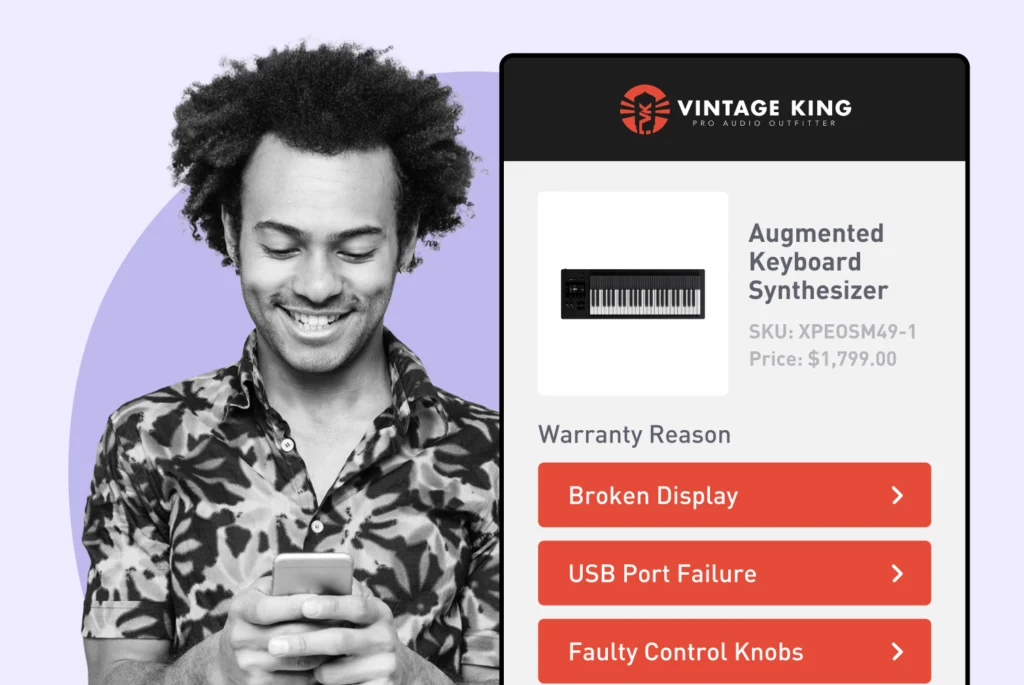
Essential Guide: How to Manage Electronics Warranty Returns
Master the essentials of electronics warranty return management with our comprehensive guide. Streamline your process and reduce hassle. Read more now!
Shipping, Tracking & Notifications
Boost customer experience and reduce support tickets
Realtime order and shipment tracking
Proactive order and shipping notifications
AI-Enhanced Discounted Labels
Predictive pre-purchase estimated delivery dates
Self-Serivce branded order tracking
Effortless experience delivered
Identify and Resolve Order Issues
Realtime order and shipment tracking
Make returns profitable and delight customers
Flexibility to define any return destinations & conditions
Simplify returns for your customers and team
Incentivize exchanges over returns
Returns management made easy for your team
Returns management made easy for your team
Easy claims and smart upsells
Understand why your customers are returning
In-Store & Curbside Pickup
Unify the online and the in-store experience
Hassle-free pickup experience for customers
In-Store dashboard to keep operations streamlined
In-Store and Online orders unified
Drive foot-traffic to your stores
Shipping, Tracking & Notifications
Boost customer experience and reduce support tickets
Realtime order and shipment tracking
Proactive order and shipping notifications
AI-Enhanced Discounted Labels
Predictive pre-purchase estimated delivery dates
Self-Serivce branded order tracking
Effortless experience delivered
Identify and Resolve Order Issues
Realtime order and shipment tracking
Make returns profitable and delight customers
Flexibility to define any return destinations & conditions
Simplify returns for your customers and team
Incentivize exchanges over returns
Returns management made easy for your team
Returns management made easy for your team
Understand why your customers are returning
In-Store & Curbside Pickup
Unify the online and the in-store experience
Hassle-free pickup experience for customers
In-Store Dashboard to keep operations streamlined
In-Store and Online orders unified
Drive foot-traffic to your stores
Boost customer experience and reduce support tickets
Realtime order and shipment tracking
Proactive order and shipping notifications
AI-Enhanced Discounted Labels
Predictive pre-purchase estimated delivery dates
Self-Serivce branded order tracking
Effortless experience delivered
Make returns profitable and delight customers
Flexibility to define any return destinations & conditions
Simplify returns for your customers and team
Incentivize exchanges over returns
Returns management made easy for your team
Equip your team for precise return checks.
Understand why your customers are returning
Unify the online and the in-store experience
Hassle-free pickup experience for customers
In-Store Dashboard to keep operations streamlined
In-Store and Online orders unified
Drive foot-traffic to your stores
Find the answer to all your questions
Take a step by step trip through our functionality to see how we can improve your ecommerce processes.
Explore the most comon questions about WeSupply
Calculate the ROI that WeSupply can bring you
Request a no strings attached review of your current shopping experience and missed conversion opportunities
Read actionable articles on how to optimize your post-purchase experience and decrease support tickets
Get inspired by stories of how our customers implemented an effortless post-purchase experience
Wondering if WeSupply is a good fit for you? Read through our use cases to see how we can help you increase conversion & improve CX!
A Deep Dive into Top Companies' Order Tracking & Returns Strategy
Find the answer to all your questions
Explore the most comon questions about WeSupply
Calculate the ROI that WeSupply can bring you
Request a no strings attached review of your current shopping experience and missed conversion opportunities
Take a step by step trip through our functionality to see how we can improve your ecommerce processes.
Read actionable articles on how to optimize your post-purchase experience and decrease support tickets
Get inspired by stories of how our customers implemented an effortless post-purchase experience
A Deep Dive into Top Companies' Order Tracking & Returns Strategy
Wondering if WeSupply is a good fit for you? Read through our use cases to see how we can help you increase conversion & improve CX!

Warranty fraud is one of the most frustrating and costly challenges in eCommerce today. Whether it’s a customer submitting a false defect claim, a third-party seller manipulating product serial numbers, or a return that turns out to be an empty box, the impact on your bottom line is real. In fact, it’s estimated that 3% to 15% of all warranty-related costs stem from fraudulent activity. For the average company’s warranty costs, which typically range from 1% to 4% of total sales, this means a significant portion of expenses can be attributed to fraud. This makes warranty fraud a major cost control issue for eCommerce businesses. Moreover, warranty fraud is a challenge faced by both industry sectors, not just eCommerce, highlighting its broad relevance and impact.
The good news? With the right blend of policy, technology, and process optimization, you can take proactive steps to protect your eCommerce store. Most companies are affected by warranty fraud, making it a widespread issue that requires attention. This article will walk you through the key strategies to reduce warranty fraud while maintaining a strong, trustworthy relationship with your customers.
Warranty fraud happens when claims exceed legitimate warranty entitlements. It includes various types of deception like submitting fake defect reports, returning used or tampered products, misrepresenting the condition of items, and submitting fraudulent claims. Fraudulent parties—including customers, service agents, and other entities—are often involved in orchestrating these schemes. Fraudulent warranty claims are deliberate attempts to obtain warranty benefits through false or misleading information, significantly increasing warranty costs and operational burdens. Warranty fraud occurs when customers, dealers, or employees attempt to claim warranty benefits beyond what they are entitled to, making it difficult for OEMs to distinguish between legitimate and fraudulent claims. Fraudulent warranty claims occupy a significant portion of warranty costs, sometimes accounting for 3-15% of total expenses.
While warranty fraud may seem like a minor issue, the financial implications are anything but. Not only does it eat into your profit margins, but it also consumes operational resources, leads to poor inventory control, and erodes trust in your warranty process. In severe cases, warranty fraud can trigger legal problems, especially if customers or third parties manipulate branded products. Enforcement is challenging because companies often lack tangible evidence to prove fraud and take decisive action. The importance of tangible evidence in detecting and proving fraudulent warranty claims cannot be overstated, as it enables companies to identify, control, and prevent further losses.
Beyond the numbers, there’s a customer experience angle too. When fraudulent claims are processed, genuine customers might face delays or increased scrutiny, leading to dissatisfaction and churn. It becomes a balancing act between catching fraud and maintaining customer loyalty.
Warranty fraud often thrives in the gaps—gaps in communication, oversight, and technology. Many eCommerce businesses, especially fast-growing ones, may not have robust controls in place. When return policies are vague or inconsistently enforced, fraudsters are quick to exploit them. The process gaps present in these areas can leave businesses vulnerable to various forms of warranty fraud.
Process gaps, such as failure to verify serial numbers or skipping thorough inspections of returned goods, can create loopholes. Simple sloppy procedures are a common cause of fraud, as basic oversights often provide easy opportunities for exploitation. Similarly, if third-party sellers or fulfillment partners aren’t aligned with your return policies, you risk exposure to partner-initiated fraud.
Finally, some warranty fraud is internal. Untrained or complicit employees can approve fraudulent claims either out of negligence or, worse, with malicious intent. In more severe cases, systematic organized crime can be involved, where fraud is carried out in a highly organized and methodical manner. Preventing this requires visibility and accountability across your entire warranty and returns operation.
Your return and warranty policy is your first line of defense. When policies are unclear or overly lenient, they become easy targets for abuse. To reduce fraud, start by tightening and clearly communicating your return and warranty terms. This section provides actionable guidelines for reducing warranty fraud as part of a comprehensive approach.
Make sure your policies:
Use plain language and avoid vague or overly technical terminology.
Include limited return windows (e.g., 15 or 30 days instead of 60+).
Specify the condition required for a return (e.g., original packaging, tags intact, no visible wear).
Outline the acceptable reasons for warranty claims and the documentation required.
Include a clause stating that you reserve the right to reject claims that don’t meet your criteria.
You might also consider implementing restocking fees for specific categories of products or return reasons. This can deter casual fraud, especially wardrobing (using a product before returning it).
Issuing refunds only to the original payment method, or offering store credit instead of cash, further reduces the appeal for bad actors. But none of this will help if customers aren’t aware of the rules—so be transparent and repetitive in your messaging. Aligning your warranty policies with the company’s strategy ensures that your approach supports broader business objectives. For maximum effectiveness, tailor your policies to your own company’s strategy, so that warranty management directly contributes to fraud reduction and customer satisfaction.
Even with strong policies, operational execution is what stops fraud in its tracks. Your service teams, especially those handling returns and claims, must be trained and equipped to detect and act on suspicious patterns. The service center plays a crucial role in processing warranty claims, performing repairs, and entering customer and product data into the warranty management system. Warranty service is an integral part of the overall process, ensuring that claims are handled properly and efficiently.
Create a consistent inspection process for returned items. Every return should be examined for signs of wear, incorrect serial numbers, missing accessories, or repackaging. Establish clear checklists so employees know exactly what to look for.
Train your agents to recognize red flags, such as frequent returns from the same customer or high-value items being returned at unusually high rates. Equip them with escalation protocols so they don’t feel pressured to approve every claim just to close a ticket.
Foster cross-departmental collaboration, especially between customer support, finance, and operations. Fraud patterns often span multiple touchpoints, and a siloed approach can miss the bigger picture. Efficient warranty management is essential for reducing fraud, controlling costs, and optimizing the warranty process across all departments.
Verification is where many eCommerce stores struggle—and where fraud often slips through. You must be able to authenticate every claim against actual purchase data. To prevent fraud, it is crucial to implement controls at each step of the process. Establishing a robust warranty control framework for claim verification helps ensure systematic detection and prevention of fraudulent activities.
At a minimum, require:
A valid order ID
Customer identification (email, name, address)
Details about the product, including serial numbers if applicable
Add tools like AVS (Address Verification System), CVV (Card Verification Value), and 3D Secure 2.0 to reduce the risk of payment-related fraud. Consider IP verification and device fingerprinting to detect patterns like multiple claims from the same user or location.
For high-risk actions—such as high-value claims or account changes—add multi-factor authentication (MFA). These measures may seem excessive for average orders, but for products with high fraud risk, they’re essential. In addition to documentation, maintaining a clear audit trail throughout the verification process is vital for transparency and effective claim audits.
One of the most powerful fraud-fighting tools in your arsenal is automation. Manual review of every warranty claim simply isn’t feasible at scale. A dedicated warranty management system (WMS) with fraud detection capabilities can save time and catch issues early. Effective technology management is essential for optimizing warranty processes, improving reliability, and supporting maintenance and service operations.
Such systems use AI and machine learning to:
Flag repeat claimants or high-risk behaviors
Detect trends across product lines or regions
Automatically block known fraud patterns
Send alerts for manual review when anomalies are detected
These advanced solutions also enhance warranty fraud detection by leveraging real-time analytics and automation to proactively identify and prevent fraudulent activities.
These tools also help reduce false positives, which means your honest customers don’t get caught in overly aggressive fraud filters.
Automation doesn’t just prevent fraud—it also streamlines legitimate claims, creating a better experience for real customers while reducing the burden on your internal teams. This leads to significant cost savings by minimizing warranty-related expenses and improving operational efficiency.
Serialization is one of the simplest but most effective ways to prevent duplicate or fake claims. By assigning a unique identifier to each product unit, you can track its lifecycle and verify that it was purchased from your store. This tracking also supports supplier recovery by ensuring accurate documentation for timely reimbursement from suppliers and improving overall warranty management efficiency.
QR codes offer another layer of protection. When linked to a digital warranty registration or authentication system, QR codes can stop fraudsters from submitting claims on products they didn’t purchase.
Additionally, tamper-evident packaging or seals (e.g., holograms, RFID tags) discourage manipulation and make it easier for your team to spot altered or fake returns.
Educate your customers on how to register their warranty or verify authenticity using these tools. When customers know you’re tracking things closely, fraud becomes much less appealing. These measures are also highly effective in reducing fraudulent warranty claims.
Real-time data is a game changer in fraud prevention. By monitoring return and warranty trends continuously, you can spot and stop fraud before it spirals. Leveraging analytics for fraud reduction enables businesses to proactively detect suspicious patterns and minimize fraudulent warranty claims.
Dashboards can show:
Return volumes by SKU, location, or customer segment
Frequency of claims by individual customers
Discrepancies between expected product lifecycle and actual return timelines
When these anomalies are flagged early, you can investigate and adjust your policies or systems as needed. For example, a spike in returns on a particular item may indicate a manufacturing issue—or a coordinated fraud attempt. Focusing on just fraud reduction as a key objective ensures that warranty management efforts are targeted and cost-effective.
Never issue a refund before inspecting a return. Your team should be trained to recognize manipulation, such as swapped serial numbers, signs of use, or missing components. Incorporating general and warranty management practices into your inspection process helps ensure consistency and strengthens your overall fraud prevention strategy.
Use physical cues like:
Tags that are placed in visible but hard-to-remove locations
Packaging that shows evidence of tampering
Product wear and tear inconsistent with claimed issues
Train your returns staff to follow a standardized inspection process, complete with checklists and escalation procedures. This reduces both human error and the chance of a fraudulent return slipping through the cracks. Provide training alongside detailed descriptions of common fraud indicators to help staff identify suspicious patterns more effectively.
Not every warranty resolution needs to involve a refund. In many cases, exchanges or store credit can satisfy the customer while also protecting your revenue. When implementing these alternatives, it is crucial to maintain a positive customer relationship by ensuring transparency and clear communication, so that fraud prevention measures do not undermine customer trust or satisfaction.
Offer incentives for customers to choose exchanges over refunds. For example, a free gift with exchange, or extra loyalty points for store credit. This not only reduces fraud risk but also increases customer retention.
You can reserve full refunds for only first-time claims or fully verified cases. By offering thoughtful alternatives, you make fraud less attractive and legitimate customers feel appreciated.
Fraud isn’t just your problem—it’s an industry-wide challenge. Solutions must be adaptable to work for diverse companies facing unique process gaps. Sharing data and insights can make a huge difference. A consulting practice can facilitate industry-wide fraud prevention by leveraging collective expertise and best practices.
Join fraud detection networks or third-party services that maintain blacklists of known fraudsters. Sync your internal blocklists across platforms like your CRM, payment processor, and WMS. The expertise of a management consultant can be invaluable in establishing robust warranty fraud management processes. Additionally, an independent consultant focusing on warranty management can provide objective, specialized guidance to strengthen your fraud prevention strategies.
Internally, encourage collaboration between departments. A customer service agent may notice something that an operations manager wouldn’t. Bringing all stakeholders together helps paint a fuller picture of potential fraud risks. Working with your own consulting practice can also deliver tailored solutions that address your organization’s specific needs.
Warranty fraud doesn’t confine itself to a single sales channel—it can strike wherever your products are sold, whether through your own eCommerce site, third-party marketplaces, or brick-and-mortar retail partners. Each channel presents its own set of vulnerabilities, making it crucial to adopt a unified approach to warranty fraud management.
To effectively prevent warranty fraud across all sales channels, invest in a robust warranty management system that centralizes warranty claims data and provides real-time fraud detection. Modern warranty management software can monitor and analyze claims as they come in, flagging suspicious patterns and helping you detect and prevent fraudulent claims before they escalate. This level of oversight is essential for identifying duplicate claims, false claims, or coordinated fraud schemes that might otherwise slip through the cracks when channels operate in silos.
Collaboration with your sales channel partners is equally important. Work together to implement consistent fraud prevention measures, such as verifying customer information at the point of sale, tracking warranty entitlement, and sharing data on suspicious claims. By aligning your fraud prevention strategies and leveraging a robust warranty management framework, you can reduce the financial impact of fraudulent activities and ensure that warranty coverage is honored only for legitimate claims.
Ultimately, addressing warranty fraud across all sales channels not only helps reduce overall warranty costs and other excess costs, but also enhances customer satisfaction by ensuring a fair and efficient warranty process. A comprehensive, channel-spanning approach to warranty management is key to protecting your business and your brand reputation in today’s complex retail landscape.
You must also ensure your warranty practices comply with local and international laws. In the U.S., for example, the “warranty of merchantability” ensures that products meet basic expectations. In Canada, “merchantable quality” laws provide similar protections.
Additionally, be aware of privacy laws like GDPR or CCPA when handling customer data for fraud detection. Make sure your technology stack complies with these regulations.
Document all warranty decisions and maintain a digital paper trail. If a claim is escalated legally, detailed records can protect your business and support your case. Drawing on over twenty years of experience in warranty management, the author emphasizes the importance of thorough documentation. Best practices for legal compliance are often outlined in technical papers, which can serve as valuable resources for staying up to date with industry standards.
Fraud tactics evolve constantly. That means your fraud prevention strategy can’t be static. Engineering and technology management plays a crucial role in adapting to new challenges by integrating innovative solutions and control frameworks into your processes. Establishing a comprehensive service strategy is essential for future-proofing your warranty fraud management and aligning it with your overall organizational goals. Establish a sustainable process that includes:
Regular policy reviews and updates
Ongoing team training and development
Periodic audits of your claims and return system
Quarterly analysis of fraud trends and KPIs
Invest in tools that are flexible and scalable. Your warranty management system should evolve as your business grows, not hold you back. Embracing digitalization in warranty management can further enhance efficiency, improve data accuracy, and streamline fraud detection.
Simplify Returns & Warranties for Your Customers & Support Team
Book a quick call with our experts to see how WeSupply can help you: simplify the Return * Warranty experience with just a few clicks, reduce customer service calls and manual processing, notify your customer about their refund, automate returns and reduce user error.
If you’re looking for a solution that reduces warranty fraud while also driving customer engagement and post-purchase revenue, WeSupply is a powerful tool to consider.
WeSupply helps ecommerce brands not only spot and prevent fraudulent warranty claims but also streamline returns, enhance customer satisfaction, and generate incremental revenue—all in one scalable platform.
Here’s how WeSupply can support your fraud prevention strategy while strengthening your brand:
Whether you’re managing a few hundred claims or thousands, WeSupply gives you the infrastructure to fight fraud, reduce support overhead, and build trust—all while turning your warranty program into a growth engine. Book a demo today!
Reducing warranty fraud in your eCommerce store isn’t just achievable—it’s critical to long-term success. By combining clear policies, cross-functional accountability, and fraud-detection technology, you can prevent abuse, protect margins, and retain customer trust.
Platforms like WeSupply make this process even smarter. From warranty registration and QR code authentication to automated claim verification, extended protection offers, and real-time insights, WeSupply helps you identify legitimate customers, deflect fraudulent claims, and streamline the entire warranty lifecycle. Bonus: You also unlock new revenue streams and stronger post-purchase engagement along the way.
Fraud prevention isn’t about policing every customer—it’s about building a proactive system that stops bad actors while rewarding honest ones with fast, transparent support. With tools like WeSupply, you can reduce operational costs, enhance customer satisfaction, and future-proof your warranty strategy—all at scale.
Combat inconvenience with proactivity & self service
Book a quick call with our experts to see how WeSupply can help you make returns easy for your customers with a beautiful, self-service solution that makes their experience easier while also providing new ways to lower costs and earn back revenue.
1. What is warranty fraud in eCommerce?
Warranty fraud in eCommerce occurs when customers or third parties submit false or exaggerated claims to gain benefits like free replacements or refunds, often by misrepresenting defects or returning used, damaged, or fake products.
2. How can I detect fraudulent warranty claims?
Use consistent return inspections, verify serial numbers, monitor suspicious patterns with data analytics, and train staff to spot red flags like frequent claims or product tampering.
3. What tools help prevent eCommerce warranty fraud?
Fraud prevention tools include warranty management systems with automation, serial number tracking, QR code registration, device/IP verification, and AI-powered anomaly detection for claim validation.
4. How does WeSupply prevent fraudulent warranty claims?
WeSupply enforces eligibility rules based on product data, verifies customer identity at registration, and uses QR codes to authenticate ownership—blocking unauthorized claims.
5. Can WeSupply help with returns and fraud detection?
Yes. WeSupply streamlines warranty returns, uses automation to detect fraud patterns, and integrates real-time insights to flag suspicious claims—minimizing costs and manual review.
6. What makes WeSupply better for fraud prevention in ecommerce?
WeSupply offers smart QR registration, strict warranty verification, and digital-first customer support—reducing fraud, increasing trust, and turning the warranty process into a loyalty-building experience.
7. Does WeSupply have an Official Shopify App?
Yes. WeSupply has an Official Shopify App. You can download it and start integrating with your Shopify Store.
8. Does WeSupply have an official Magento extension?
Yes, WeSupply has an official extension for Magento. The WeSupply x Magento integration allows for automating order tracking experiences, reducing customer inquiries, automating shipping email and SMS notifications, and providing a fully branded order tracking experience
9. Does WeSupply have an official BigCommerce App?
Yes, WeSupply has an official BigCommerce App. You can integrate WeSupply with your BigCommerce store to improve your post-purchase customer experience.

Learn How To Create Successful Post Purchase Email Campaigns
Build an effective post-purchase email flow that helps you increase customer satisfaction and drive revenue growth!

Master the essentials of electronics warranty return management with our comprehensive guide. Streamline your process and reduce hassle. Read more now!

Learn effective strategies for offering self-service warranty returns that enhance customer satisfaction and streamline your process!

Discover how warranties can boost customer loyalty and drive repeat purchases in online stores. Learn effective strategies to enhance your sales. Read more!

Discover the top 10 ecommerce warranty management software solutions to enhance your business efficiency and customer satisfaction. Read the article now!

Discover key insights from NRF 2024 to enhance your retail strategy. Learn actionable tips for success and stay ahead in the competitive market. Read more!

Learn effective strategies for offering self-service warranty returns that enhance customer satisfaction and streamline your process!

Simplify your warranty claims process with Shopify automation. Discover practical strategies to streamline and enhance efficiency!

Learn effective strategies to calculate and reduce your ecommerce return rate. Improve profitability and customer satisfaction!

Discover the risks of incomplete data destruction and learn how to safeguard your information. Read on for essential insights to protect your data.